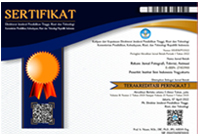The Recontextualization of Parang Rusak Barong Batik Into Animated Characters
Abstract
Keywords
Full Text:
PDFReferences
Journal
Irawan, B. (2019). Three dimensional aspect of a main character Mathilde in Guy de Maupassant’s the necklace. Morphosis: Journal of Literature, 1(1), 1-7.
Books
Bancroft, T. (2006). Creating Characters With Personality. New York: Watson-Guptill Publications.
Bishop, R., Boo, S., Cruz, M. R., & Gadea, L. (2020). Fundamentals of Character Design: How to Create Engaging Characters for Illustration, Animation & Visual Development. United Kingdom: 3dtotal Publishing.
Hutcheon, L., & O'Flynn, S. (2006). A Theory of Adaptation. Second Edition. New York: Routledge.
Irawan, B. (2019). Three Dimensional Aspect of a Main Character Mathilde in Guy De Maupassant’s THE NECKLACE. MORPHOSIS: JOURNAL OF LITERATURE. Vol. 1 No. 1, 1-7.
Kusrianto, A. (2013). Batik Filosofi, Motif, dan Kegunaan. Yogyakarta: Penerbit Andi.
Roberts, S. (2011). Character Animation Fundamentals Developing Skills for 2D and 3D Character Animation. United Kingdon: Focal Press, Elsevier Ltd.
Seger, L. (2017). Writing Subtext. What Lies Beneath. 2nd Edition. CA: Michael Wiese Productions.
Website
Imama Lavi Insani. 2016. Retrieved November, 28 2024, from https://www.goodnewsfromindonesia.id/2016/03/28/makna-batik-parang-yang-tak-sembarangan
Keraton Jogja. 2018. Retrieved November, 28 2024, from https://www.kratonjogja.id/kagungan-dalem/12-motif-batik-larangan-keraton-yogyakarta/
The Batik Website. Parang Rusak Barong Motif. Retrieved November, 28 2024, from https://thebatikwebsite.wordpress.com/motif-batik-larangan/parang-rusak-barong-motif/
DOI: https://doi.org/10.24821/rekam.v21i1.15037
Refbacks
- There are currently no refbacks.

This work is licensed under a Creative Commons Attribution 4.0 International License.




